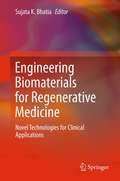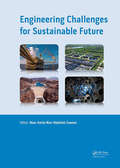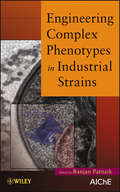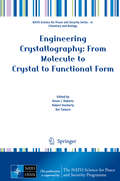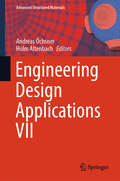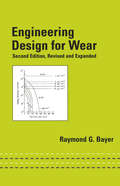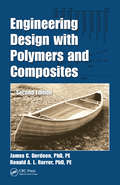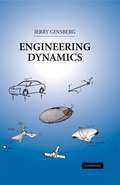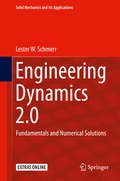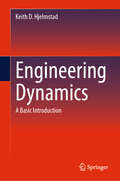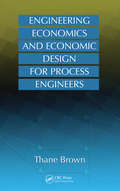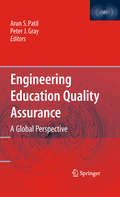- Table View
- List View
Engineering Biomaterials for Regenerative Medicine
by Sujata K. BhatiaRegeneration of tissues and organs remains one of the great challenges of clinical medicine, and physicians are constantly seeking better methods for tissue repair and replacement. Tissue engineering and regenerative medicine have been investigated for virtually every organ system in the human body, and progress is made possible by advances in materials science, polymer chemistry, and molecular biology. This book reviews the current status of biomaterials for regenerative medicine, and highlights advances in both basic science and clinical practice. The latest methods for regulating the biological and chemical composition of biomaterials are described, together with techniques for modulating mechanical properties of engineered constructs. Contributors delineate methods for guiding the host response to implantable materials, and explain the use of biologically-inspired materials for optimal biological functionality and compatibility. The book culminates in a discussion of the clinical applications of regenerative medicine. By integrating engineering and clinical medicine, Engineering Biomaterials for Regenerative Medicine examines how tissue engineering and regenerative medicine can be translated into successful therapies to bridge the gap between laboratory and clinic. The book will aid materials scientists and engineers in identifying research priorities to fulfill clinical needs, and will also enable physicians to understand novel biomaterials that are emerging in the clinic. This integrated approach also gives engineering students a sense of the excitement and relevance of materials science in the development of novel therapeutic strategies.
Engineering Ceramics: Fabrication Science and Technology
by D.P. ThompsonThis 50th volume in the British Ceramics Proceedings series includes papers presented at a meeting of the Basic Science Section held in Manchester, UK in December 1991.
Engineering Challenges for Sustainable Future: Proceedings of the 3rd International Conference on Civil, Offshore and Environmental Engineering (ICCOEE 2016, Malaysia, 15-17 Aug 2016)
by Noor Amila Wan Abdullah ZawawiEngineering Challenges for Sustainable Future contains the papers presented at the 3rd International Conference on Civil, Offshore & Environmental Engineering (ICCOEE2016, Kuala Lumpur, Malaysia, 15-17 August 2016), under the banner of World Engineering, Science & Technology Congress (ESTCON2016). The ICCOEE series of conferences started in Kuala Lumpur, Malaysia 2012, and the second event of the series took place in Kuala Lumpur, Malaysia 2014. This conference series deals with the civil, offshore & environmental engineering field, addressing the following topics:• Environmental and Water Resources Engineering• Coastal and Offshore Engineering• Structures and Materials• Construction and Project Management• Highway, Geotechnical and Transportation Engineering and Geo-informatics This book is an essential reading for academic, engineers and all professionals involved in the area of civil, offshore and environmental engineering.
Engineering Complex Phenotypes in Industrial Strains
by Ranjan PatnaikThis book highlights current trends and developments in the area of engineering strains. The book details the current and future tools used in the production of bulk chemicals and biofuels from renewable biomass using green technologies. Complex phenotypes are traits in a microbe that requires multiple genetic changes to be modulated simultaneously in the microorganism's DNA. Knowing what those genetic changes are for a given trait and how to make those changes in the most efficient way forms the motivation behind writing this book. This book explains the newer tools to develop and enable engineered strains at time scales much faster that the natural evolution process so that we can increase a cells' production of a certain substance, increase process productivity, and extend metabolic capability. This book provides a one stop platform of reference for practicing researchers in the field of industrial biotechnology. This book also explains that the commercial success of a process that uses microbial catalysts over platforms that use chemical catalysts and fossil fuels depends on the time it takes to engineer these microbes to perform the desired reaction under harsh manufacturing conditions and at rates that meets the criteria for economic feasibility.
Engineering Crystal Habit: Applications of Polymorphism and Microstexture Learning from Nature (Topics in Applied Physics #152)
by Fumitaro Ishikawa Hiroaki Ohfuji Jun Kawano Tetsuya ToheiThis book compiles reviews of both fundamental and applied research in physics and materials science, focusing on the existence, formation mechanisms, and artificial synthesis of versatile, nature-inspired crystals. It aims to highlight the development and application of advanced crystals with novel polymorphism and microtextures, resulting in the innovation of completely new and unexpected functionality. The book encompasses five main topics; the first three focus on fundamental research in mineralogy in the areas of polymorphism and microtexture in biological environments, crystallographic structure, and nucleation and growth. The last two parts address applied research devoted to microtexture and polymorphism in electronics and photonics applications. The featured topics comprise contributions from international groups of active researchers in the field. The book is a valuable tool for a wide readership ranging from graduate students to researchers and engineers. The broad coverage of topics is attractive to readers from diverse fields including crystal engineering, drug development, electronic materials, electronic devices, and mineralogy.
Engineering Crystallography: From Molecule to Crystal to Functional Form
by Rui Tamura Kevin J. Roberts Robert DochertyThis book highlights the current state-of-the-art regarding the application of applied crystallographic methodologies for understanding, predicting and controlling the transformation from the molecular to crystalline state with the latter exhibiting pre-defined properties. This philosophy is built around the fundamental principles underpinning the three inter-connected themes of Form (what), Formation (how) and Function (why). Topics covered include: molecular and crystal structure, chirality and ferromagnetism, supramolecular assembly, defects and reactivity, morphology and surface energetics. Approaches for preparing crystals and nano-crystals with novel physical, chemical and mechanical properties include: crystallisation, seeding, phase diagrams, polymorphic control, chiral separation, ultrasonic techniques and mechano-chemistry. The vision is realised through examination of a range of advanced analytical characterisation techniques including in-situ studies. The work is underpinned through an unprecedented structural perspective of molecular features, solid-state packing arrangements and surface energetics as well as in-situ studies. This work will be of interest to researchers, industrialists, intellectual property specialists and policy makers interested in the latest developments in the design and supply of advanced high added-value organic solid-form materials and product composites.
Engineering Design Applications V: Structures, Materials and Processes (Advanced Structured Materials #171)
by Andreas Öchsner Holm AltenbachThis book gives an update on recent developments in different engineering disciplines such as mechanical, materials, computer and process engineering, focusing on modern engineering design applications. These disciplines provide the foundation for the design and development of improved structures, materials and processes. The modern design cycle is characterized by an interaction of different disciplines and a strong shift to computer-based approaches where only a few experiments are performed for verification purposes. A major driver for this development is the increased demand for cost reduction, which is also connected to environmental demands. In the transportation industry (e.g., automotive), this is connected to the demand for higher fuel efficiency, which is related to the operational costs and the lower harm for the environment. One way to fulfill such requirements is lighter structures and/or improved processes for energy conversion. Another emerging area is the interaction of classical engineering with the health, medical and environmental sector. The chapters are selected contributions of the Advanced Computational Engineering and Experimenting conference, held in July 2022 in Florence, Italy.
Engineering Design Applications VI: Structures, Materials and Processes (Advanced Structured Materials #209)
by Andreas Öchsner Holm AltenbachThis book gives an update on recent developments in the mentioned areas of modern engineering design application. Different engineering disciplines such as mechanical, materials, computer and process engineering provide the foundation for the design and development of improved structures, materials and processes. The modern design cycle is characterized by an interaction of different disciplines and a strong shift to computer-based approaches where only a few experiments are performed for verification purposes. A major driver for this development is the increased demand for cost reduction, which is also connected to environmental demands. In the transportation industry (e.g. automotive), this is connected with the demand for higher fuel efficiency, which is related to the operational costs and the lower harm for the environment. One way to fulfil such requirements are lighter structures and/or improved processes for energy conversion. Another emerging area is the interaction of classical engineering with the health, medical, and environmental sectors.
Engineering Design Applications VII (Advanced Structured Materials #230)
by Andreas Öchsner Holm AltenbachThis book gives an update on recent developments in the mentioned areas of modern engineering design application. Different engineering disciplines such as mechanical, materials, computer, and process engineering provide the foundation for the design and development of improved structures, materials, and processes. The modern design cycle is characterized by an interaction of different disciplines and a strong shift to computer-based approaches where only a few experiments are performed for verification purposes. A major driver for this development is the increased demand for cost reduction and higher efficiency, which is also connected to environmental demands. One way to fulfil such requirements is lighter structures and/or new composite materials and structures. Another emerging area is the interaction of classical engineering with the health, medical, and environmental sector.
Engineering Design for Wear, Revised and Expanded (Mechanical Engineering)
by Raymond G. BayerA modern presentation of approaches to wear design, this significantly revised and expanded second edition offers methods suited for meeting specific wear performance requirements, numerous design studies highlighting strategies for use with different tribological elements and mechanical systems, proven tactics for resolving wear-related problems,
Engineering Design with Polymers and Composites
by James C. Gerdeen PhD PE Ronald A.L. Rorrer PhD PEEngineering Design with Polymers and Composites, Second Edition continues to provide one of the only textbooks on the analysis and design of mechanical components made from polymer materials. It explains how to create polymer materials to meet design specifications. After tracing the history of polymers and composites, the text describes modern des
Engineering Design with Solidworks 2015 and Video Instruction
by David C. PlanchardEngineering Design with Solid Works 2015 and video instruction is written to assist students, designers, engineers and professionals. The book provides a solid foundation in Solid Works by utilizing projects with step-by-step instructions for the beginner to intermediate SolidWorks user. Explore the user interface, CommandManager, menus, toolbars and modeling techniques to create parts, assemblies and drawings in an engineering environment.
Engineering Disease Resistance in Plants using CRISPR-Cas
by Zulqurnain KhanCRISPR genome-editing technology presents opportunities to engineer disease resistance traits in plants and improve crop quality. Engineering Disease Resistance in Plants using CRISPR-Cas introduces readers to the basics of CRISPR-Cas and discusses its potential uses in various fields. The book focuses on methods of developing disease-resistant crops using CRISPR-Cas–mediated plant disease resistance modification. Comprehensively written, the author details all types and variants of the CRISPR toolkit. The book opens with information on the evolution of the CRISPR technology and follows a chronology of its development. Although the book concentrates on the use of CRISPR-Cas for disease resistance in plants, it also covers the technology's broader potential examining the history and development of other genome-editing tools. Key Features: Investigates the regulatory, ethical, and societal considerations while designing experiments. Discusses topics on disease development, control, and plant defense mechanisms. Examines genome-editing tools including Zinc Finger Nucleases (ZFNs) and Transcription Activator-Like Effector Nucleases (TALENs). Examines production technology to reduce bacterial, fungal, and viral diseases. Provides information for users to discover ways to overcome the challenges associated with food security. This book is a valuable resource for researchers, scientists, and undergraduate and graduate students who wish to gain a comprehensive understanding of genome-editing methods.
Engineering Dynamics
by N. Jeremy Kasdin Derek A. PaleyThis text is a modern vector oriented treatment of classical dynamics and its application to engineering problems. Based on Ginsberg's Advanced Engineering Dynamics Second Edition, it develops a broad spectrum of kinematical concepts, which provide the framework for formulations of kinetics principles following the Newton-Euler and analytical approaches. This fresh treatment features many expanded and new derivations, with an emphasis on both breadth and depth and a focus on making the subject accessible to individuals from a broad range of backgrounds.
Engineering Dynamics
by Jerry GinsbergThis text is a modern vector oriented treatment of classical dynamics and its application to engineering problems. Based on Ginsberg's Advanced Engineering Dynamics Second Edition, it develops a broad spectrum of kinematical concepts, which provide the framework for formulations of kinetics principles following the Newton-Euler and analytical approaches. This fresh treatment features many expanded and new derivations, with an emphasis on both breadth and depth and a focus on making the subject accessible to individuals from a broad range of backgrounds.
Engineering Dynamics 2.0: Fundamentals and Numerical Solutions (Solid Mechanics and Its Applications #254)
by Lester W. SchmerrThis book presents a new approach to learning the dynamics of particles and rigid bodies at an intermediate to advanced level. There are three distinguishing features of this approach. First, the primary emphasis is to obtain the equations of motion of dynamical systems and to solve them numerically. As a consequence, most of the analytical exercises and homework found in traditional dynamics texts written at this level are replaced by MATLAB®-based simulations. Second, extensive use is made of matrices. Matrices are essential to define the important role that constraints have on the behavior of dynamical systems. Matrices are also key elements in many of the software tools that engineers use to solve more complex and practical dynamics problems, such as in the multi-body codes used for analyzing mechanical, aerospace, and biomechanics systems. The third and feature is the use of a combination of Newton-Euler and Lagrangian (analytical mechanics) treatments for solving dynamics problems. Rather than discussing these two treatments separately, Engineering Dynamics 2.0 uses a geometrical approach that ties these two treatments together, leading to a more transparent description of difficult concepts such as "virtual" displacements.Some important highlights of the book include: Extensive discussion of the role of constraints in formulating and solving dynamics problems.Implementation of a highly unified approach to dynamics in a simple context suitable for a second-level course.Descriptions of non-linear phenomena such as parametric resonances and chaotic behavior.A treatment of both dynamic and static stability.Overviews of the numerical methods (ordinary differential equation solvers, Newton-Raphson method) needed to solve dynamics problems.An introduction to the dynamics of deformable bodies and the use of finite difference and finite element methods.Engineering Dynamics 2.0 provides a unique, modern treatment of dynamics problems that is directly useful in advanced engineering applications. It is a valuable resource for undergraduate and graduate students and for practicing engineers.
Engineering Dynamics: A Basic Introduction
by Keith D. HjelmstadThis book provides an innovative approach to learning dynamics of particles and rigid bodies, emphasizing a consistent problem-solving framework designed to help students understand the subject while building and reinforcing the mathematical tools needed to bridge the gap between physical intuition and quantitative results. The theoretical developments are supported by an extensive set of MATLAB codes that give the reader powerful tools for exploring and visualizing basic concepts. The book is aimed at engineering students at the sophomore level who have a background in calculus, linear algebra, and differential equations. Uses clear and consistent derivations of the basic concepts of dynamics and provides an extensive set of MATLAB codes Embraces direct vector notation from the start and presents a consistent numerical framework for solving nonlinear differential equations Simplifies one of the most difficult aspects of dynamics—relative motion—using a novel approach to kinematics
Engineering Dynamics: Fundamentals and Applications
by M Rashad Islam A K Mazumder Mahbub AhmedThis textbook is intended for the first course of engineering dynamics for undergraduate students. Engineering dynamics is a rigorous topic that typically involves the intensive use of vector mathematics and calculus. This book, however, uses plain language with less vector mathematics and calculus to introduce these topics of mathematics to students with a high school physics background. Numerous practical examples are provided with their step-by-step worked out solutions, as well as case studies to reflect the interests of new engineering and applied engineering students. The topics covered in the Fundamentals of Engineering (FE) examination are presented throughout the text. It also includes roadway dynamics to incorporate engineering dynamics and transportation engineering for civil engineering. Features: Discusses theory using easy-to-understand language with less vector mathematics and calculus Includes practical case studies and numerous realistic step-by-step solved examples Includes exercise problems for students’ practice Provides numerous sample examples related to the Fundamentals of Engineering (FE) exam Includes a solutions manual and PowerPoint slides for adopting instructors Engineering Dynamics: Fundamentals and Applications serves as a useful resource for students across several engineering degree programs, such as civil, mechanical, aerospace, automotive, chemical, and electrical engineering. It is also appropriate for engineering technology and applied science students as well.
Engineering Earth: The Impacts of Megaengineering Projects
by Stanley D. BrunnThis is the first book to examine the actual impact of physical and social engineering projects in more than fifty countries from a multidisciplinary perspective. The book brings together an international team of nearly two hundred authors from over two dozen different countries and more than a dozen different social, environmental, and engineering sciences. Together they document and illustrate with case studies, maps and photographs the scale and impacts of many megaprojects and the importance of studying these projects in historical, contemporary and postmodern perspectives. This pioneering book will stimulate interest in examining a variety of both social and physical engineering projects at local, regional, and global scales and from disciplinary and trans-disciplinary perspectives.
Engineering Economics and Economic Design for Process Engineers
by Thane BrownEngineers often find themselves tasked with the difficult challenge of developing a design that is both technically and economically feasible. A sharply focused, how-to book, Engineering Economics and Economic Design for Process Engineers provides the tools and methods to resolve design and economic issues. It helps you integrate technical a
Engineering Eden: The True Story of a Violent Death, a Trial, and the Fight over Controlling Nature
by Jordan Fisher SmithThe fascinating story of a trial that opened a window onto the century-long battle to control nature in the national parks. When twenty-five-year-old Harry Walker was killed by a bear in Yellowstone Park in 1972, the civil trial prompted by his death became a proxy for bigger questions about American wilderness management that had been boiling for a century. At immediate issue was whether the Park Service should have done more to keep bears away from humans, but what was revealed as the trial unfolded was just how fruitless our efforts to regulate nature in the parks had always been. The proceedings drew to the witness stand some of the most important figures in twentieth century wilderness management, including the eminent zoologist A. Starker Leopold, who had produced a landmark conservationist document in the 1950s, and all-American twin researchers John and Frank Craighead, who ran groundbreaking bear studies at Yellowstone. Their testimony would help decide whether the government owed the Walker family restitution for Harry's death, but it would also illuminate decades of patchwork efforts to preserve an idea of nature that had never existed in the first place. In this remarkable excavation of American environmental history, nature writer and former park ranger Jordan Fisher Smith uses Harry Walker's story to tell the larger narrative of the futile, sometimes fatal, attempts to remake wilderness in the name of preserving it. Tracing a course from the founding of the national parks through the tangled twentieth-century growth of the conservationist movement, Smith gives the lie to the portrayal of national parks as Edenic wonderlands unspoiled until the arrival of Europeans, and shows how virtually every attempt to manage nature in the parks has only created cascading effects that require even more management. Moving across time and between Yellowstone, Yosemite, and Glacier national parks, Engineering Eden shows how efforts at wilderness management have always been undone by one fundamental problem--that the idea of what is "wild" dissolves as soon as we begin to examine it, leaving us with little framework to say what wilderness should look like and which human interventions are acceptable in trying to preserve it. In the tradition of John McPhee's The Control of Nature and Alan Burdick's Out of Eden, Jordan Fisher Smith has produced a powerful work of popular science and environmental history, grappling with critical issues that we have even now yet to resolve.
Engineering Education Quality Assurance
by Peter Gray Arun PatilThe goal of this book is to provide a global perspective on the past, present and future of engineering education quality assurance. The objectives are to describe the history of engineering education quality assurance within a global higher education context, provide the first world-wide review of existing quality assurance schemes in engineering education and the issues related to their development and implementation, and present a generic Global Model of Engineering Quality Assurance based on the lessons learned in the past that may guide future developments in engineering education quality assurance.
Engineering Education for the Next Generation: A Nature-inspired Approach
by Samuel Cord StierGuide your students through the fascinating world of engineering, and how to draw inspiration from Nature’s genius to create, make, and innovate a better human-built world. Studded with more than 150 illustrations of natural phenomena and engineering concepts, this fascinating and practical book clearly demonstrates how engineering design is broadly relevant for all students, not just those who may become scientists or engineers. Mr. Stier describes clever, engaging activities for students at every grade level to grasp engineering concepts by exploring the everyday design genius of the natural world around us. Students will love learning about structural engineering while standing on eggs; investigating concepts in sustainable design by manufacturing cement out of car exhaust; and coming to understand how ant behavior has revolutionized the way computer programs, robots, movies, and video games are designed today. You will come away with an understanding of engineering and Nature unlike any you’ve had before, while taking your ability to engage students to a whole new level. Engineering Education for the Next Generation is a wonderful introduction to the topic for any teacher who wants to understand more about engineering design in particular, its relation to the larger subjects of STEM/STEAM, and how to engage students from all backgrounds in a way that meaningfully transforms their outlook on the world and their own creativity in a lifelong way. · Fun to read, comprehensive exploration of cutting-edge approaches to K-12 engineering education · Detailed descriptions and explanations to help teachers create activities and lessons · An emphasis on engaging students with broad and diverse interests and backgrounds · Insights from a leading, award-winning K-12 engineering curriculum that has reached thousands of teachers and students in the U.S. and beyond · Additional support website (www.LearningWithNature.org) providing more background, videos, curricula, slide decks, and other supplemental materials
Engineering Elasticity: Elasticity with less Stress and Strain
by Humphrey HardyThis textbook aimed at upper-level undergraduate and graduate engineering students who need to describe the large deformation of elastic materials like soft plastics, rubber, and biological materials. The classical approaches to finite deformations of elastic materials describe a dozen or more measures of stress and strain. These classical approaches require an in-depth knowledge of tensor analysis and provide little instruction as to how to relate the derived equations to the materials to be described. This text, by contrast, introduces only one strain measure and one stress measure. No tensor analysis is required. The theory is applied by showing how to measure material properties and to perform computer simulations for both isotropic and anisotropic materials. The theory can be covered in one chapter for students familiar with Euler-Lagrange techniques, but is also introduced more slowly in several chapters for students not familiar with these techniques. The connection to linear elasticity is provided along with a comparison of this approach to classical elasticity.
